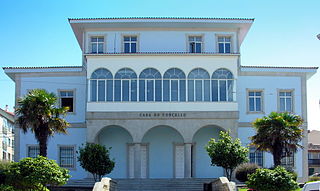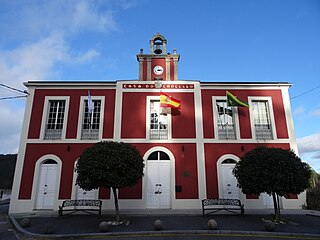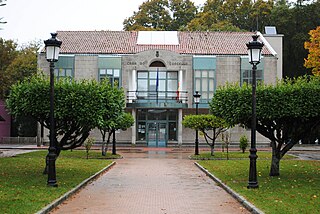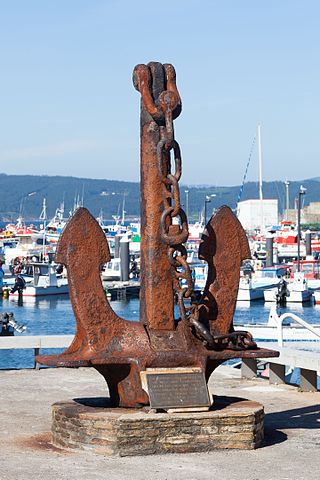
Galicia is an autonomous community of Spain and historic nationality under Spanish law. Located in the northwest Iberian Peninsula, it includes the provinces of A Coruña, Lugo, Ourense, and Pontevedra.

Pontevedra is a city in the autonomous community of Galicia, in northwestern Spain. It is the capital of both the Comarca and Province of Pontevedra, and the capital of the Rías Baixas. It is also the capital of its own municipality which is often considered an extension of the actual city.

Allariz is a town and municipality in the province of Ourense, in the autonomous community of Galicia, Spain. It occupies the center of the western half of the province, connecting with the towns (concellos) of Taboadela, Paderne, Sandiás, Vilar de Santos, Rairiz de Veiga, Xunqueira de Ambía, A Merca and A Bola. The area of the municipality is 85,3 km² and there are 6.188 inhabitants in 16 parishes.

Vigo is a city and municipality in the province of Pontevedra, within the autonomous community of Galicia, Spain. Located in the northwest of the Iberian Peninsula, it sits on the southern shore of an inlet of the Atlantic Ocean, the Ria de Vigo, the southernmost of the Rías Baixas. It is the capital of the comarca of Vigo.

Lugo is a city in northwestern Spain in the autonomous community of Galicia. It is the capital of the province of Lugo. The municipality had a population of 98,025 in 2018, making it the fourth most populous city in Galicia.

Viveiro is a town and municipality in the province of Lugo, in the autonomous community of Galicia, Spain. It belongs to the comarca of A Mariña Occidental. It borders on the Cantabrian Sea, to the west of Xove and to the east of O Vicedo. It has a residential population of over 16,000, which however triples in the summer months with visitors to the coastal region.

San Cibrao, is an industrial and fishing town, part of Cervo in Northwestern Spain. The population of San Cibrao is about 3,000 in July and August and about 2,000 year-round.

Castro culture is the archaeological term for the material culture of the northwestern regions of the Iberian Peninsula together with the Spanish regions of Galicia, Asturias, and western León) from the end of the Bronze Age until it was subsumed by Roman culture. It is the culture associated with the Gallaecians and Astures.

Boimorto is a municipality in the province of A Coruña, in the autonomous community of Galicia, northwestern Spain. It is located in the comarca of Arzúa. It has an area of 82.71 km2, a population of 2,486, and a population density of 30.06 people/km2. Coordinates: 43° 00' 27" N - 8° 07' 37" W. Elevation: 487 m.

Porto do Son is a municipality in the province of A Coruña, in the autonomous community of Galicia, Spain. It belongs to the comarca of Noia. The municipality of Porto do Son encompasses a collection of coastal towns and villages in from including the town of Porto do Son itself, and other towns such as Portosín. The area is around 25 km by 6 km and has many beaches along with some famous Celtic ruins, the castro called the "Castro de Baroña".

Galicians are a European ethnic group from northwestern Spain; it is closely related to the northern Portuguese people and has its historic homeland in Galicia, in the north-west of the Iberian Peninsula. Two Romance languages are widely spoken and official in Galicia: the native Galician and Spanish.

Antas de Ulla, is a municipality in the province of Lugo, in the autonomous community of Galicia, Spain. It begins in the territory of the Ulla river, which marks the boundaries of the municipality with the neighboring municipalities of Monterroso and Palas de Rey, municipalities with which make up the comarca of A Ulloa.

Ourol is a municipality in the province of Lugo, in the autonomous community of Galicia, Spain. It belongs to the comarca of A Mariña Occidental.

As Nogais is a municipality in the province of Lugo, in the autonomous community of Galicia, Spain. It belongs to the comarca of Os Ancares. It is 57 kilometers from the city of Lugo. It had a population of 1,381 in 2009 according to the Municipal Register of Inhabitants.

O Saviñao is a Concello (council) in the province of Lugo, Galicia belonging to the district of Terra de Lemos. The main town for the council is Escairón.

Cason was a cargo ship, under a Panamanian flag, carrying 1,100 tonnes of various toxic and flammable chemicals. On 5 December 1987 the ship caught fire off the coast of Galicia, Spain. 23 of the 31 crew died, including the captain. The ship grounded off Cape Finisterre and broke up.

The Convent of St Dominic is a former Dominican monastery in Santiago de Compostela, Galicia, Spain.

The Castro de Baroña is an Iron Age fortified settlement located in the parish of Baroña, a municipality of Porto do Son in the province of A Coruña. The settlement, surrounded by two walls and containing twenty roundhouses that still remain today, was built on a peninsula and inhabited from the 1st Century BC to the 1st Century AD.

Tui Cathedral is a late-Romanesque and Gothic-style Roman Catholic church in the town of Tui, in Galicia, Spain. It is located at San Fernando square, in the center of the town.

Florentino López Alonso-Cuevillas was a Spanish anthropologist and prehistorian, although in the course of his life he also became involved in writing, primarily essays and fiction. Like several other Galician intellectuals of his generation, he was a member of Xeración Nós, of the Seminar of Galician Studies and the Irmandades da Fala, combining the cultural and linguistic activities he carried out in those institutions with a discrete participation in pro-Galician politics. However, his social and political activities were profoundly disrupted by the victory of nationalists in the Spanish Civil War, although in the 1940s he returned to his commitment to the spread of Galician culture as a full member of the Royal Galician Academy, and of the Instituto de Estudios Gallegos Padre Sarmiento.





















